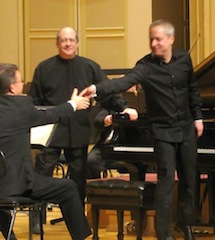
Everything about Friday morning’s Cincinnati Symphony concert at Music Hall was exceptional: guest artist, Jeremy Denk, who turned in an exceptional performance of Mozart’s Piano Concerto No. 25 in C Major; the program, led by the exceptional Robert Spano, including a rare performance of Ralph Vaughan Williams’ “London Symphony” (No. 2); and an exceptional audience of plus-or-minus 200 who braved the impending snowstorm to be there.
Spano, music director of the Atlanta Symphony, opened the concert with Vaughan Williams’ Fantasia on a Theme of Thomas Tallis. Scored for divided string orchestra, the well-loved work -- based on a hymn tune by English Renaissance composer Thomas Tallis – was fully at home on the Music Hall stage. There was ample space to distance the two groups from each other, as the composer specified. The smaller ensemble (nine players) was seated in the back, on the right side of the stage behind the proscenium arch, with the main orchestra in front. Taken together, they created wonderful echo effects and interweaving of lines. There were affecting solos by violinists Timothy Lees and Gabriel Pegis, violist Christian Colberg and cellist Ilya Finkelshtyn.
Denk gave brilliant voice to Mozart’s Piano Concerto No. 25 in C Major (K.503). His fingers moved swift as lightning in the outer movements, and he filled Mozart’s melodic moments with abundant charm. The first movement cadenza, by Denk himself, was amazing for its agility, and the serene Adagio was meltingly beautiful in his hands. A particularly welcome aspect of the performance was the close working relationship between Denk and the CSO led by Spano. Every aspect of the music was perfectly aligned, from the solos within the orchestra which complemented Denk and vice versa, to overall ensemble unity.
Vaughan Williams “London Symphony” provided a color-filled travelogue. (Interestingly, one of the earliest recordings of the work was by the CSO led by music director Eugene Goossens in 1941.) Though not intended to be programmatic, it is cinematic in effect and Vaughan Williams himself provided a kind of scenario in his notes on the work. After a soft, misty opening, all the bustle of London can be heard – listen for the “Westminster Chimes” (Big Ben striking the hour), played by harp and clarinet before the city awakens. There was abundant melody in the second movement, which moved from wistful to passionate and back, ending with a soulful statement by Colberg.
The Scherzo (Nocturne) was playful and animated, evoking London at night, according to Vaughan Williams. After its quiet end, the music waxed triumphant in the finale. The march-like principal theme proved both nostalgic and celebratory, followed by a repeat of the “Westminster Chimes” on harp. The symphony’s extraordinary epilogue conjures a journey down the River Thames toward the open sea (again, Vaughan Williams notes), with the history of London – and England – passing by in review. Spano and the CSO gave it a tender reading, with a big swell just before the end.
The concert repeats
at 8 p.m. tonight at Music Hall. Tickets begin at $12. Call (513) 381-3300, or
order online at www.cincinnatisymphony.org